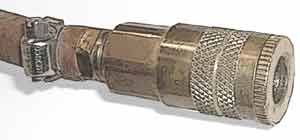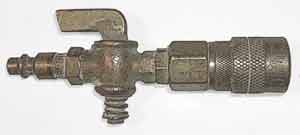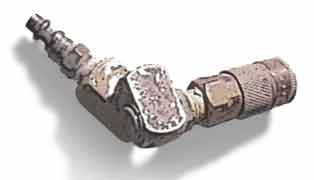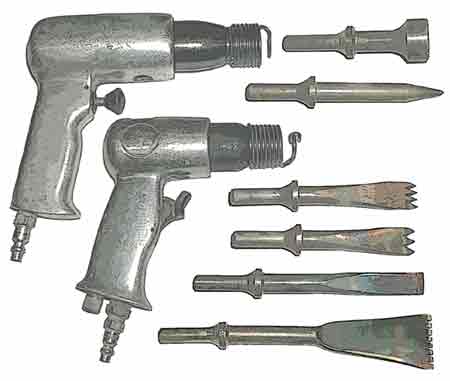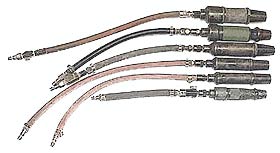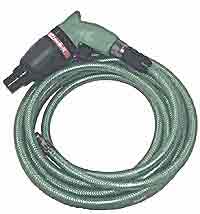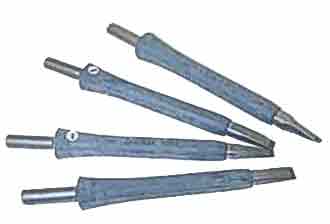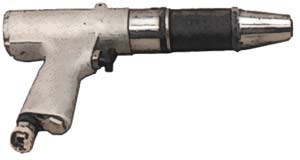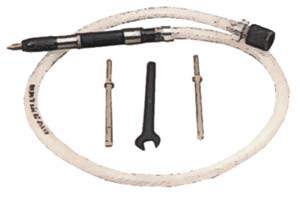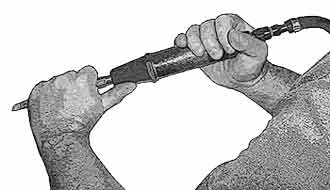 | ||||
 | ||||
 | ||||
home / about the artist / stoneboat series / lipwork series / metaphorical presences / landscapes / multi-element installation pieces / recent works
technical processes / thumbnail galleries / Cortona foundry / Finland stone carving / recommended reading / all in the family / links page
www.dondougan.com
DON DOUGAN
PNEUMATIC HAMMERS
TRADITIONAL PROCESSES
 | ||||
 | ||||
 | ||||
 | ||||
 | ||||
The Trow and Holden Company in Vermont introduced the Pneumatic Carving Hammer to the
stoneworking industry in 1890, and the company
continues to make top quality tools for the stone carver.
Other companies who manufacture Carving Hammers are
the Dallet Company (now defunct), Bicknell Manufacturing
(Maine), and Cuturi (Italy).
 | ||||
The female quick-connect fitting is attached to the discharge end of incoming supply hose.
another type of air hammer
Note the in-line air valve fitted to the small finishing hammer (at left) which allows minute adjustments of the air feed for greater control.
The pneumatic hammer has only
one moving part — the piston (the
darker crosshatched portion in the cut-
away drawing at right) that travels
back-and-forth in the body of the
tool and strikes the end of the chisel.
Another type of pneumatic hammer that is
more commonly available than the stone
carving hammers above. These pistol-grip
type hammers (at right) are made for ripping
and hammering sheet metal, and minor
demolition work of masonry. The least
expensive versions cost about a tenth of the
price of the standard stone carving
hammers, though the value of a good quality
tool of this type will be more - though still
less than a hammer designed for stonecarving.
The shank of the chisels made to fit in these
hammers is smaller than those that fit regular
carving hammers, and the chisel also has a
shaped flange that fits the spring holder on
the end of the hammer. The range of styles
of chisels available to fit these hammers is
very limited: a point, a flat chisel, a
hammering face, and several sheet-metal
ripping styles not pictured.
More commonly available than the stone
carving hammers above, these pistol-grip
type hammers (at right) are made for ripping
and hammering sheet metal, and minor
demolition work of masonry.
NOTE: The three tooth chisels pictured were my
modifications from straight flat chisels.
 | ||||
 | ||||
Though a main shut-off valves should be attached to the compressor, the installation of quick-connect fittings on the in-line supply valve (as on the example shown at right) allows a greater flexibility when interchanging hoses and different tools on the same supply line.
Though not an essential fitting, swiveling-elbow joints like this allow the carver a much greater degree of freedom of movement while attached to the sometimes heavy and awkward rubber supply hose from the compressor.
This example has both male and female quick-connects fitted so it can be used or removed easily as needed.
The pneumatic hammer comes in several sizes and types, the most common of which accepts chisels with a 1/2" diameter shank. The size and type of hammer is varied to accommodate the needs of the carver and type of work being performed.
The larger of the two hammers at left is used primarily for roughing-out work on harder varieties or larger blocks of stone, while the smaller 'short-stroke' hammer at left allows a much greater degree of control for the carver in the later stages of work when carving finishing details.
The size of pneumatic carving hammer to use
will depend not only on the type of carving and
the hardness of the stone being carved, but also
on the balance and weight in the user's hands.
For general work I find the 3.2 lb. long stroke
Dallet hammer to be the best compromise
between carving power and comfort. And for
detail carving, after buying the 2.2 lb. Trow and
Holden 1/2" short-stroke I rarely reach for the
small long-stroke hammers anymore.
4.6 lbs.
Cuturi
4.3 lbs.
Dallet
3.2 lbs.
Dallet
2.4 lbs.
long stroke
2.1 lbs.
long stroke
2.2 lbs.
Trow & Holden
short stroke
The air compressor and the rubber supply hoses should have quick-connect fittings at both the supply and discharge ends of the hose.
The quick-connects allow the various air driven tools to be switched easily as the work requires.
Pneumatic hammers are difficult to wear-out — four of the six hammers below were bought secondhand from carver's who told me they bought them in the1920s and '30s. These old hammers work almost as well as the Trow and Holden and Cuturi hammers purchased new in 1991.
The corresponding male quick-connect fitting at the end of the whip attached to the intake on the pneumatic tool, or to the intake end of a supply hose.
The air hammers should be attached to a short length of rubber air hose (called a whip) to prevent the hammer vibrations from damaging the quick-connect fittings. The exact length of the whip should provide an easily accessible and comfortable location for the connections and in-line air control valve while working.
 | ||||
 | ||||
To the novice carver these hammers are very appealing for a couple of reasons — the relatively low initial expense and the familiar switch and grip style similar to an electric drill. But I have found that if the carving student has the option of becoming familiar with both styles of hammer, it is usually this pistol-grip type of hammer that is discarded in favor of the regular stone carving style hammer. Though these pistol-grip hammers are certainly serviceable, for my own work it comes down to the greater degree of control afforded by the loose socket and the generally longer shank-length of the chisels made to fit those regular stone carving hammers.
On the other hand, in French stonecarving supply stores
there is a similar type of carving hammer to this (the shank
is differently shaped)
that is widely used by
numerous monument
carving shops in France.
(at left)
Lettering chisels to fit the French pneumatic
carving hammer (at right)
 | ||||
And finally, for the carver who wants both the versatility of the loose socket Carving Hammer and the pistol grip style, an Italian design combines both into one tool. The one pictured (at left) is comparable in size and power to the mid-size hammer (3.2 lb. Dallet), though it weighs a bit more because of the handle.
NOTE: hammer is shown with the typical Italian-style of quick-connect which joins by a screw-twist method rather than the snap-on type shown above.
For those carvers who work in a small scale or in need the flexibility of a small tool to get into tight areas there is made a small pneumatic carving hammer — sometimes called a pneumatic pen — that can be held in one hand much like a writing pen, though using it with two hands will allow a greater degree of control.
The example pictured is an Italian design, though there are similar designs made by American manufacturers.
 | ||||

